

TOGAF. James Smith's Blogs. About the Author TOGAF 9 and Enterprise Architecture related articles Share this: Share Like this: Like Loading... 2 thoughts on “TOGAF 9” Thank you so much for this blog.
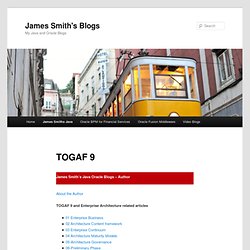
Introduction to Enterprise Architecture. Quality Standards. ISO/IEC 9126. ISO/IEC 9126 Software engineering — Product quality was an international standard for the evaluation of software quality.
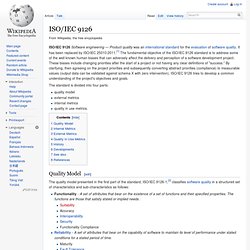
It has been replaced by ISO/IEC 25010:2011.[1] The fundamental objective of the ISO/IEC 9126 standard is to address some of the well known human biases that can adversely affect the delivery and perception of a software development project. These biases include changing priorities after the start of a project or not having any clear definitions of "success.
" By clarifying, then agreeing on the project priorities and subsequently converting abstract priorities (compliance) to measurable values (output data can be validated against schema X with zero intervention), ISO/IEC 9126 tries to develop a common understanding of the project's objectives and goals. The standard is divided into four parts: quality modelexternal metricsinternal metricsquality in use metrics. Quality Model[edit] Each quality sub-characteristic (e.g. adaptability) is further divided into attributes.
Certification. Requisite Certifications: Software Architecture Design and Analysis. A system's software architecture is widely regarded as one of the most important software artifacts.
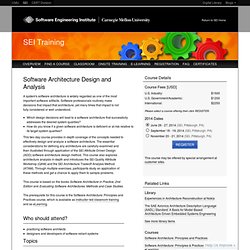
Software professionals routinely make decisions that impact that architecture, yet many times that impact is not fully considered or well understood. Which design decisions will lead to a software architecture that successfully addresses the desired system qualities? How do you know if a given software architecture is deficient or at risk relative to its target system qualities? This two-day course provides in-depth coverage of the concepts needed to effectively design and analyze a software architecture. The essential considerations for defining any architecture are carefully examined and then illustrated through application of the SEI Attribute-Driven Design (ADD) software architecture design method.
This course is based on the books Software Architecture in Practice, 2nd Edition and Evaluating Software Architectures: Methods and Case Studies. Who should attend? Topics Objectives. OO Principles. Ootips - Object Orientation Tips. Principles Of Object Oriented Design. Microsoft. MSDN Architecture Center. Arch. Links. Design Guide. Evolutionary Architecture and Design Perhaps the biggest shift in my thinking during my career has been towards an evolutionary approach to architecture and design.
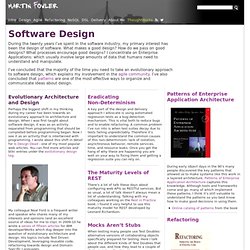
When I was first taught about software design, it was as an activity separated from programming that should be completed before programming began. Now I see it as an activity that is intertwined with programming. I wrote about this shift in detail for Is Design Dead - one of my most popular web articles. You can find more articles and bliki entries under the evolutionary design tag. Main Page - Guidance Share. Consulting Resources for Software Architects and Enterprise Architects. Patterns. Chapter 3: Architectural Patterns and Styles. For more details of the topics covered in this guide, see Contents of the Guide.
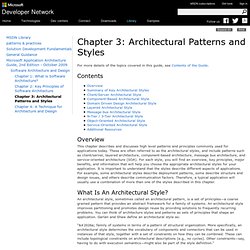
This chapter describes and discusses high level patterns and principles commonly used for applications today. These are often referred to as the architectural styles, and include patterns such as client/server, layered architecture, component-based architecture, message bus architecture, and service-oriented architecture (SOA). For each style, you will find an overview, key principles, major benefits, and information that will help you choose the appropriate architectural styles for your application. It is important to understand that the styles describe different aspects of applications. For example, some architectural styles describe deployment patterns, some describe structure and design issues, and others describe communication factors.
“ߪa; family of systems in terms of a pattern of structural organization. An understanding of architectural styles provides several benefits. Higher security. Catalog of Patterns of Enterprise Application Architecture. Last Significant Update: January 2003 A short summary of the patterns in Patterns of Enterprise Application Architecture (P of EAA). | Japanese | Russian | These pages are a brief overview of each of the patterns in P of EAA.
They aren't intended to stand alone, but merely as a quick aide-memoire for those familiar with them, and a handy link if you want to refer to one online. In the future I may add some post-publication comments into the material here, but we'll see how that works out. Many of these diagrams demonstrate the rather poor GIF output of Visio. Domain Logic Patterns: Transaction Script (110), Domain Model (116), Table Module (125), Service Layer (133). Design Patterns. Object Oriented Design. Enterprise Architecural References. Enterprise Architecture. MSDN Library.
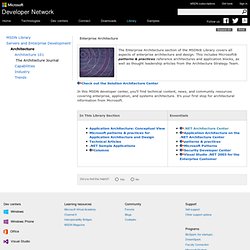
Fear Those Tiers. Udi Dahan December 2007 Summary: Tiers and networks are not to be taken lightly, in any architecture.
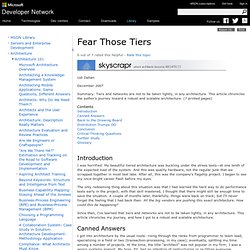
This article chronicles the author's journey toward a robust and scalable architecture. (7 printed pages) Architectural Books. 10 Papers Every Software Architect Should Read (At Least Twice) Roles. ITAC and the Enterprise Architect - Certification Magazine. IT architecture is becoming the discipline that separates success from failure in large or complex IT projects.
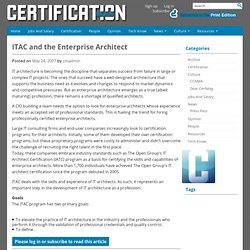
The ones that succeed have a well-designed architecture that supports the business need as it evolves and changes to respond to market dynamics and competitive pressures. But as enterprise architecture emerges as a true (albeit maturing) profession, there remains a shortage of qualified architects. A CIO building a team needs the option to look for enterprise architects whose experience meets an accepted set of professional standards. This is fueling the trend for hiring professionally certified enterprise architects. Large IT consulting firms and end-user companies increasingly look to certification programs for their architects. ITAC deals with the skills and experience of IT architects. GoalsThe ITAC program has two primary goals: A Study of Architect Roles by IASA Sweden.
By Daniel Akenine Contents IntroductionWhy We Need ArchitectsA Process to Map Artifacts to LevelsArchitect RolesBiggest ChallengesConclusionResources Introduction In this article, we first examine why there is a need for IT architects.
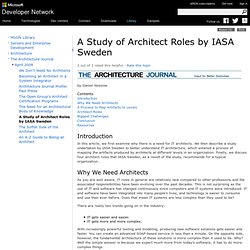
We then describe a study undertaken by IASA Sweden to better understand IT architecture, which entailed a process of mapping the artifacts produced by architects at different levels in an organization. Why We Need Architects As you are well aware, IT roles in general are relatively new compared to other professions and the associated responsibilities have been evolving over the past decades. There are really two trends going on in the industry: IT gets easier and easier. With increasingly powerful tooling and modeling, producing new software solutions gets easier and faster.
Many years ago, I got a telephone call from a friend. In this context, let's consider some of the reasons often given for why architects are important.